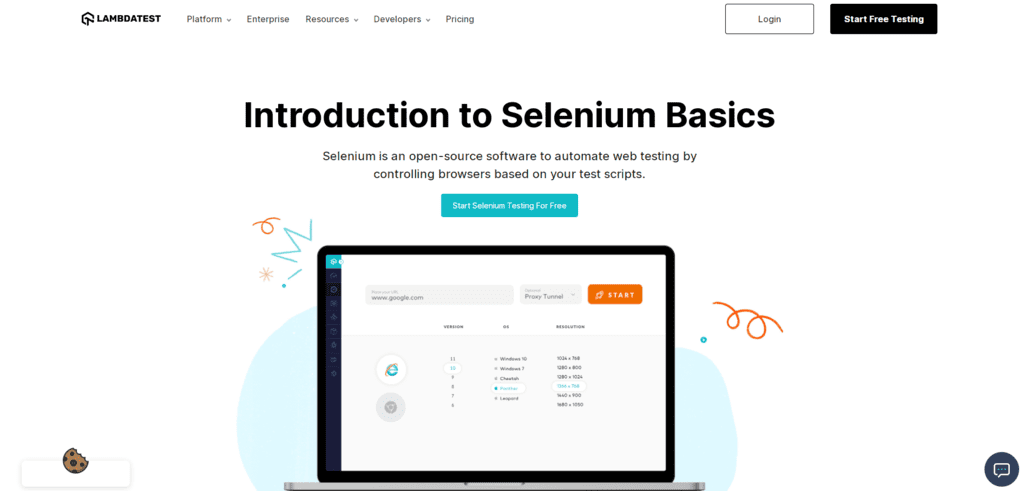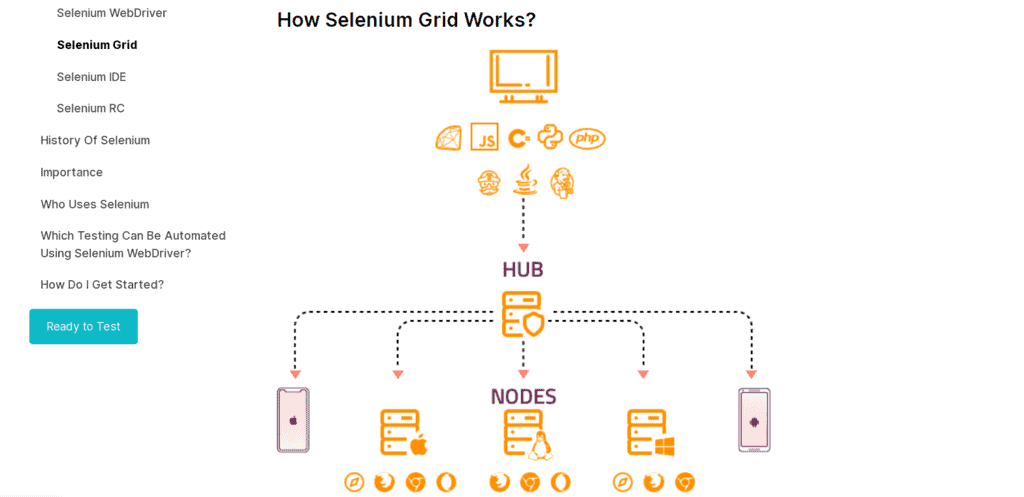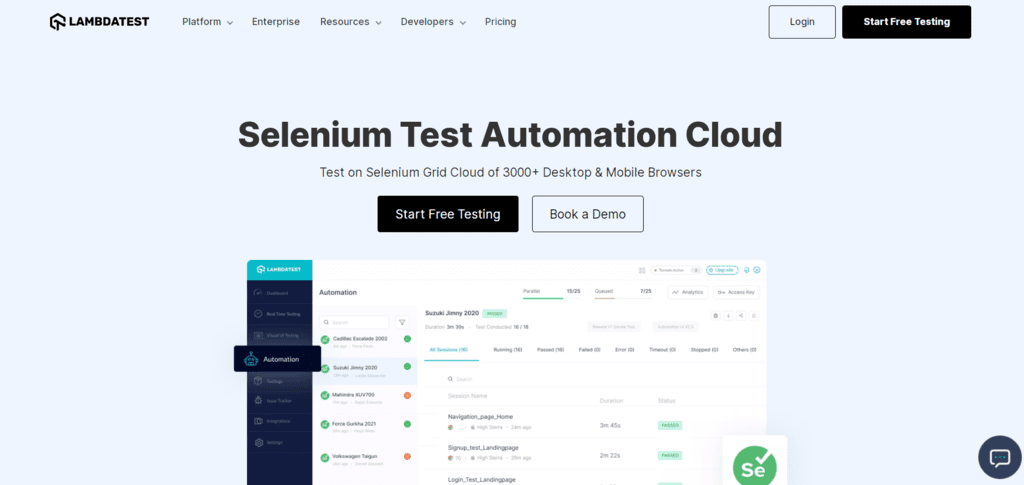Many companies prefer Selenium to perform cross-browser compatibility testing on their web applications. It is one of the most popular frameworks to implement automation testing in a web development environment. We can define cross-browser testing as the process of ensuring the web application is functional irrespective of the browser or browser version. This is one of the crucial steps as it ensures optimal performance on any device or operating system combination.
The fourth version of Selenium is the latest one that has been released in 2018. Since it was initially released, it has managed to gain a lot of popularity. It is mainly due to the interactive and revolutionary features offered by this test automation framework.
The stable version of Selenium 4 has not been released till now. You have the option to download the beta version of Selenium 4. It is available on the official website. While considering Selenium 4 with the future of automation testing in mind, it indeed offers various improvements and enhancements.
For instance, it provides various new APIs, an improved Integrated Development Environment, relative locators, new Selenium grid architecture, W3C standardized protocol, and many more. The primary focus of this article will be to discuss the various improvements and enhancements in Selenium 4. Lastly, we will try to justify whether it is worth upgrading to this new version of Selenium.
But before we get into detail on that. We want to give all those of you looking to start a site the last holiday treat of 2021. WPMU DEV’s all-in-one platform makes it easy for anyone to create and manage websites. Get 20% off any of their plans. Free trial included.
Various New Additions in Selenium WebDriver 4

One of the most Revolutionary changes of Selenium 4 WebDriver is the complete support for W3C with the WebDriver APIs. Thus, the developers can finally eliminate the hassle of encoding and decoding every API aspect with the help of JSON protocol. The JSON protocol was the standard procedure of all the encoding and decoding processes in Selenium 4 and its earlier versions. With the help of this coding mechanism, the developer can facilitate the communication between Browsers and test scripts.
With this new feature, the developers can stabilize the cross-browser testing processes. Now, the WebDriver can directly interact with the native code base of any Browser. One thing that developers must consider is that this change will not affect the existing users. This is because all the popular browser drivers like ChromaDriver and GeckoDriver have already adopted the latest W3C algorithms.
One of the important features of Selenium 4 is that it eliminates JSON Protocol. The standardization of W3C architecture for WebDriver APIs is a product of this massive change. This change will become one of the critical elements in driving the efficiency and stability of automated web browser testing in the coming years.
All the Unique Features of Selenium
Various Enhancements of the Selenium Grid

In the earlier versions of the Selenium grid, it was a complex process to set up and implement. However, Selenium 4 adds the docker support for the Selenium grid. Using this new feature, that developers can simply spin up the containers without having to spend lots of time in the setup process. You can also deploy the grids without scaling them according to the project. In simple terms, Selenium 4 simplifies the test Management process. The developers no longer have to spend lots of time setting up and managing the hubs and nodes separately.
1. Massive Improvements in the Selenium IDE
The Selenium Integrated Development Environment is probably the most popular record and playback tool available in the Selenium environment. In the earlier versions of Selenium, this feature was only available as an add-on to Mozilla Firefox. Recently, Mozilla Firefox has completely removed this feature for its Browser. This is because it made all the versions of add-ons a standard part of the web extension mechanism. Thus, Selenium 4 played a vital role in the revival of the integrated development environment. The IDE became an integral part of all major browsers like Chrome and Firefox.
2. Addition of the Support for Chrome Debugging Tools
The latest version of Selenium has support for all Chrome DevTools protocols. Using this feature, the quality assessment teams can use various tools like profiler, performance management, network features, and many more. The developers can use the data from these tools to analyze the performance of the web application in poor network bandwidth. They can also perform geolocation testing to ensure the web application is accessible to the audience base irrespective of the location.
Developers can also use this feature to test various critical bugs on the web application. They will not require any form of setup as they can test on the go using the Browser itself. The Chrome debugging tools also help developers to test the functioning of the web application using various Chrome extensions. These extensions are available from the official Chrome extension Store.
3. Improved Management of Various Tabs
It is common for a developer to open a certain process in a separate tab during cross-browser compatibility testing. In older versions like Selenium 3, the developers had to define a separate driver object for this purpose. After that, they had to perform the switch to the respective Tab with the help of the Window handle method. It was one of the most tedious and time-consuming processes. However, Selenium 4 adds a new API that is known as newWindow.
Using this feature, the developers can easily add a new tab for conducting different testing processes. They no longer have to define a new driver object for each tab. This is another major improvement of Selenium 4 to improve the time efficiency of the testing process.
Role of Selenium 4 in Automation Testing

Before we discuss the role of Selenium in Automation Testing, we need to understand the history of Automation testing. During the initial years of software development, all the testing processes had to be conducted manually. This means that for cross-browser testing, the developers had to test the compatibility of the web application on each Browser manually. This resulted in massive losses as the companies witnessed huge drains in terms of time and resources. Companies also failed to deliver the application on time to the end-users.
This was one of the major reasons for the rise of automation testing in the web Development Industry. Automation Testing helps the developers to conduct all the redundant processes with automated test scenarios.
Selenium 4 adds various new features that facilitate the simple execution of test automation. For instance, it helps the developers to natively check the compatibility of the web application on multiple browsers at the same time. It also supports the integration of various programming languages and other tools. The developers can use the Selenium WebDriver to implement various modern testing features like continuous development, integration of CI/CD tools, and functional testing.
Improved Support for Test Automation Tools
Test automation tools are one of the most important ways to increase the efficiency of a testing environment. Using these tools, the developers can conduct various processes like the automation of test cases, verifying the validity of test scripts, and many more. However, the developers must remember that they cannot simply choose any random tool and integrate it into the development environment. This is because every tool is unique, and it serves a different purpose in the developing environment.
As a developer, you must conduct a thorough background check to understand which tool is perfect for your web application project. During this process, you can also consider the project requirements and your preferences.
The developers should also conduct a thorough background check on the reliability of the test automation tool or framework. An effective way of conducting this process is to check various reviews on online user forums. In these forums, you can find millions of honest reviews of customers who are currently using this tool. Selenium 4 improves its support for various test automation tools with the help of Selenium WebDriver. Let us use LambdaTest to justify this concept.
LambdaTest is a platform to perform automated cross-browser testing on a safe and Secure Selenium grid. Using this platform, you can verify the compatibility of a web application on thousands of browsers, devices, and operating systems at the same time. Lambdatest combines the Selenium 4 WebDriver with the cloud platform to simplify the Automation Testing process. Using this feature, you can test the compatibility of the web application from anywhere in the world.
LambdaTest also helps the developers to verify the cross-browser compatibility of locally hosted web applications. It maintains an interactive activity log to store all the final test reports for future reference. Currently, LambdaTest is used by millions of web developing companies all around the world. It is also one of the very few tools that allow developers to perform visual testing of web applications.
Is the Upgrade Worth It?

Based on all the exciting features that we discussed in this article, it is a clear answer that you should upgrade to Selenium 4. You should consider all these changes thoroughly to ensure that existing test cases are not affected. You should also allocate ample time to make the necessary changes in the testing environment and adapt to it. Features such as full-screen screenshots and better visibility will go a long way in improving the final test reports. Moreover, since it is the beta version, we can also expect that more features can also be added to the stable version.
The Final Verdict
So, we can easily justify that all the new features and improvements in Selenium 4 are very useful to improve the software testing framework. The testers can use all these new features to simplify the web testing process and save a lot of development time. They can, in turn, use this time to focus on other key areas like improving the features of the web application. As a developer, you must remember that you should never rely on a cloud platform to complete all the testing processes.
This is because cloud platforms, emulators, and virtual machines will always not provide accurate data like a real device. Certain tests like visual testing and compatibility of the graphical user interface should always be performed on real devices. You should also choose a test automation tool that helps to maintain the balance between cloud platforms and real devices.
In this competitive web developing industry, you cannot afford to make a single error in the final web application. A single error is enough to cause huge losses and drastically affect the user retention of a company. All the new features of Selenium 4 will help a company to ensure a bright future for the business.
